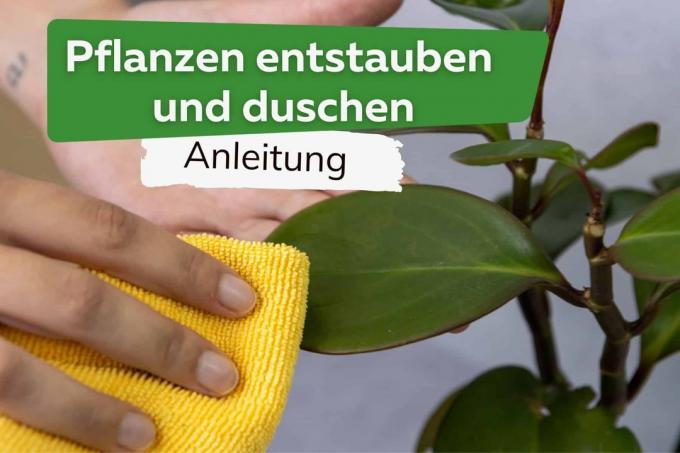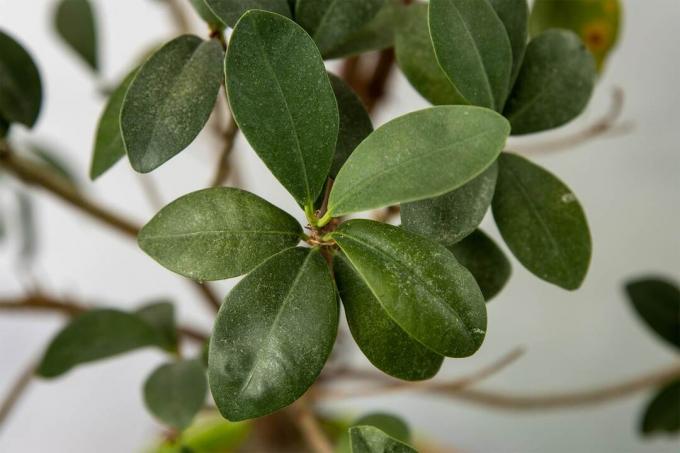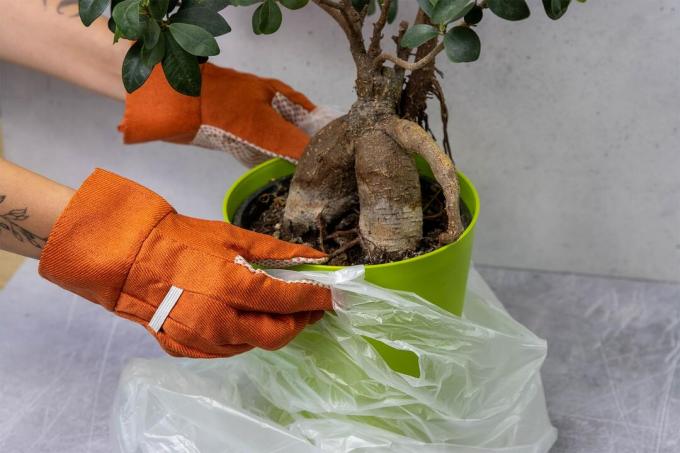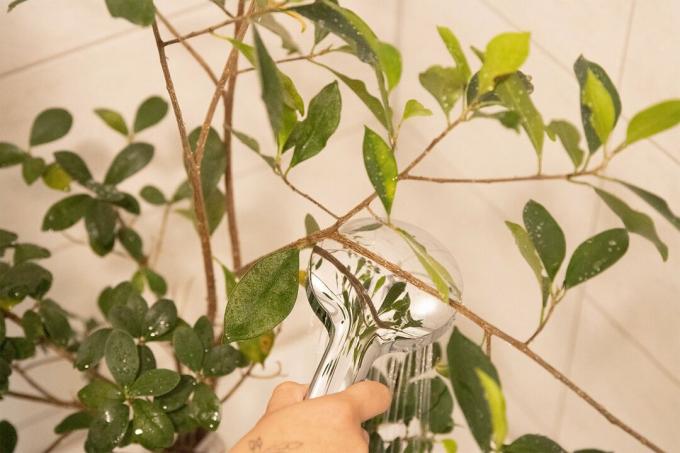
It's only a matter of time before the leaves of any houseplant are thickly covered in dust. Some specimens then need a shower to make their green shine again. We will show you the best way to dust off your plants.
In a nutshell
- Dust must be removed from the top and bottom of the leaves
- large-leaved plants with a damp cloth, shower plants with small leaves
- Rinse with a lukewarm stream from top to bottom
- as required, but at least 1x per year
- Protect potting soil with plastic bag
Table of contents
- Method is plant dependent
- Dust plants with a cloth
- Shower plant - preparation
- shower off the plant
- frequently asked Questions
Method is plant dependent
Specimens with large or few leaves can be dusted with a cloth like pieces of furniture. For indoor plants with many small leaves, this method is too tedious and time-consuming. These plants can be showered. Showering is also recommended for plants with heavily frayed or sharp-edged leaves.

Dust plants with a cloth
Dusting works quite well with a dry cloth. But the leaves become “clean down to the pores” when the cloth is moistened.
- use a soft cloth
- Water should be lukewarm and without additives
- wipe each sheet individually
- start at the top of the plant
- Work downwards leaf by leaf
- Wipe the top and bottom of the leaves
- Dust thick stalks carefully
- If necessary, rinse the cloth with water from time to time

A notice: Place your free hand under the sheet while wiping it with your other hand. This allows you to apply light pressure without the blade yielding and breaking.
Shower plant - preparation
You can shower off in the shower or in the bath.
Check feasibility
First, determine if the plant can be easily lifted and carried, or otherwise transported to the shower. Does it fit through the door frame? When it comes to bathtubs, it is important to consider whether they can easily be lifted and stood in them.
organize help
Organize two helping hands and/or a transport trolley if the plant is very heavy or large. If a plant is densely covered with greenery, it can also block your view. Then it is helpful if another person makes sure that they do not bump into anything and that all shoots remain intact.
Pack pot in bag
In the shower she can Earth washed out, or at least soaked more than the plant would like. Since the soil doesn't dry out again that quickly, it needs to be protected in order to rot to prevent. This is easy to do if you put the pot in a large plastic bag and tie it at the top.

Protection against water splashes
Keep in mind that even with all caution, the jet of water can bounce off the leaves. Draw the shower curtain or close the shower walls. Put things further away that could get splashed.
Set water temperature and water jet
The plant should be dusted with lukewarm water. First test the correct temperature setting with your hand before directing the water jet at the plant. The softer the leaves of the houseplant are, the softer the water jet should be. In general, start with a weaker beam. You can always increase it if you see that the plant can take harder water jets.
shower off the plant
Direct the water jet towards the top of the plant. Once top sheets are dust-free from above and below, move on to the sheets below, and so on. In this way, the "dust water" does not come into contact with leaves that have already been cleaned. Turn the pot so you can shower the plant from all sides.

Drain briefly
If time allows, leave the plant in the shower for a few hours to dry it out. Otherwise, gently shake their shoots to shake off most of the water.
remove bag
Remove the protective bag so that any water that collects on it cannot spill onto the ground.
Temporarily place in semi-shade
This recommendation applies to plants that have a window seat in full sun. Temporarily place it in partial shade until completely dry. Because leaves wetted with water can sun exposure get burns.
Tip: You can also shower the plant without a bag with a little water pressure and thus save yourself the step of watering. Important! The plant must then drain well to avoid waterlogging.
frequently asked Questions
Dusting is not just an aesthetic matter. This is also absolutely necessary for the health of the plant. Because the more dust it is covered with, the less light and Co2 it can absorb.
Every houseplant should get at least one shower per year. The actual dust load on the leaves decides whether to take further showers. If you live on a busy street, you may need to remove dust every month.
You may be able to enlist the help of nature. Pay attention to the weather forecast, when (not to pattering) rain is announced. Then place the plant outside in the garden or on an uncovered balcony. The rain will wash away the dust. Here, too, protect the soil from waterlogging with a plastic bag.
Some indoor plants, such as the popular window leaf, have many aerial roots, some of which are strong, on which dust can also collect. Do not dust these roots with the damp cloth, but carefully with a fine feather duster.
